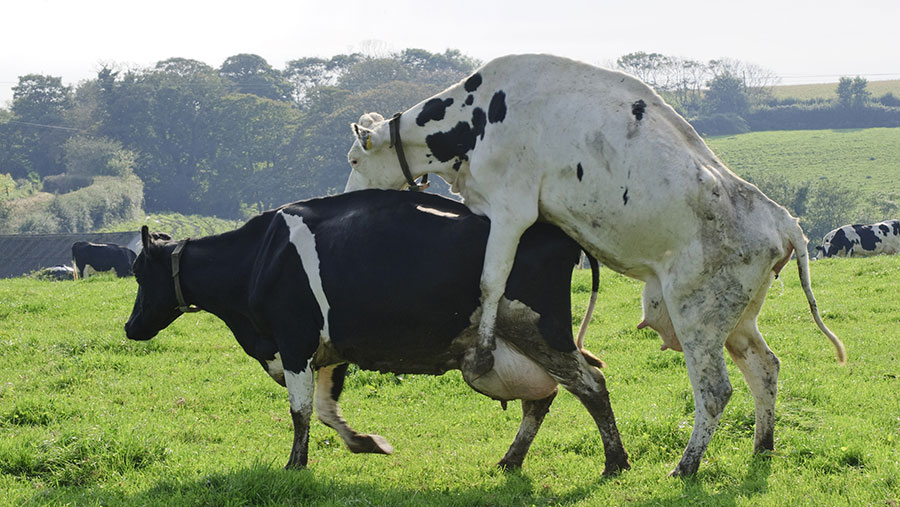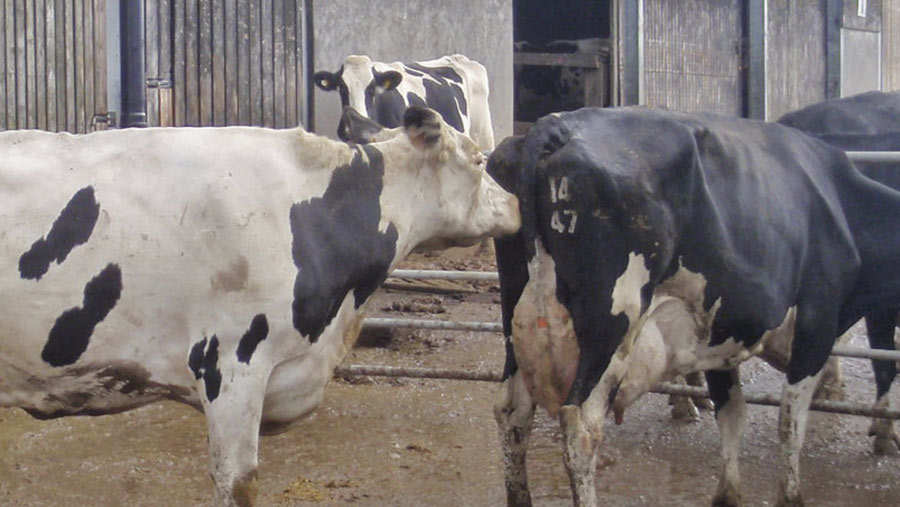5 common heat detection methods reviewed
 © John Eveson/FLPA/imageBROKER/REX/Shutterstock
© John Eveson/FLPA/imageBROKER/REX/Shutterstock Spotting cows in heat is a perennial challenge facing dairy farmers. Increasing cow performance means issues are often seen with both the proportion of cows cycling normally and the level of behavioural expression shown by cows.
Westpoint vet Tonia Simms, RCVS advanced practitioner in bovine reproduction, reviews five common methods used to detect oestrus and provides a refresher on how to get the best from each.
See also: Pick the right heat detection system for your farm
1. Visual observation
Despite the rise of automatic heat detection systems, a large number of heats are still spotted visually. Many studies over the years have underlined the importance of setting aside dedicated time to do this.
In a 2006 study, more than 80% of farmers cited they detected heats by “knowing their cows” but less than 20% had planned observation times.
In a 2006 study, more than 80% of farmers cited they detected heats by “knowing their cows” but less than 20% had planned observation times.
Advice for improving heat detection rates (HDR):
- Standing to be mounted (StbM) is the best sign of oestrus, however, animals that aren’t inseminated can’t conceive. So if she shows all other signs (mucus discharge, swelling and reddening of vulva, restlessness, chin and back rubbing or sniffing) serve her. The pregnancy rate from other signs is only about 5% less than StbM.
- Most oestrus behaviours occur at times other than the 30 minutes after feeding and the two hours either side or during milking so avoid these periods.
- The highest HDR (86%) is achieved by observing the cows for 30 minutes five times a day. This is often unachievable and second best is observing for 30 minutes twice a day (63%). Any time less than 30 minutes leads to missed heats.

2. Mount detectors
Mount detectors can be a useful addition to observed oestrus as they give information on activity which occurs at times when the cows are not being observed.
Mount detectors come in a variety of forms including; tail paint, scratch cards and ink pockets.
Advice for improving HDR:
- The key, as with any aid, is to apply them correctly and ensure they are used in an environment where they can be effective. For example, tail paint may not be the best solution in a shed with automatic cow brushes as it will be rubbed off.
- The HDR for mount detectors ranges from 48-80% and is similar to observation and activity monitors if read correctly.
3. Activity monitors
There are various systems available, with sensors/accelerometers placed on the neck or the foot.
Advice for improving HDR:
- Research suggests pedometers may give the best heat detection although data quality does depend on the activity threshold value set for a heat alert and the upload frequency from the sensors to the software so good internet connection is key.
- HDRs are normally high (80-90%) but with an increased false positive rate as other causes of increased activity may also be recorded as a heat. With this in mind, any heat alert which occurs at an unexpected time (for example, outside of the usual returns window, or in a cow thought to be pregnant) should be treated with caution. Checking the animal for vaginal slime, or presentation during a routine fertility visit.
- The HDR from activity monitors increases further when combined with visual observation – further demonstrating the value of stockmanship and interpretation.
4. Milk progesterone
The gold standard heat detection is by testing a cow’s milk for progesterone.
During most of her cycle, this hormone remains high in the body and milk.
When she comes bulling, progesterone drops meaning a low concentration in her milk indicates she is ready to serve.
Using milk progesterone reduces the amount of false positive heats by 6% and has an overall HDR of nearly 100%. It will also allow detection of other problems such as cystic ovaries.
New technology allows for inline milk progesterone samples to be taken in the parlour, particularly in robots, however, uptake has been slow, mainly due to the high expense involved.
5. Fixed-time artificial insemination synchronisation programmes
Some herds in the UK are turning to fixed-time AI synchronisation protocols to eliminate the need to detect heats.
Blanket use of synchronisation protocols is unlikely to be popular with consumers and is already outlawed in some dairy contracts due to the use of synthetic hormones in clinically normal animals.
However, synchronising cows that are not overtly expressing heats is an important part of a herd’s reproductive management, as well as treating those with abnormal ovarian activity, such as anoestrus or cysts.
The additional bonus of synchronising is that it creates a bulling group which will encourage more oestrous behaviour in cohort cows, thus improving your overall heat detection.
Advice for improving HDR:
- The important thing is to present cows that have not been seen bulling to the vet so that they can identify any issues and instigate the synchronisation protocol.
Summary
In practice, the best heat detection would combine some if not all of the above.
However, even with the best technology, all heat detection is limited by the effects of the environment and management systems; HDR will be reduced if cows do not feel safe to walk and mount other cows. Negative energy balance or poor body condition will also reduce the HDR.
So any concerns with heat detection should consider the whole farm as well as the available technologies.
Good fertility requires a team approach and involving your vet, nutritionist and any farm consultants used will all help in maximising performance.
